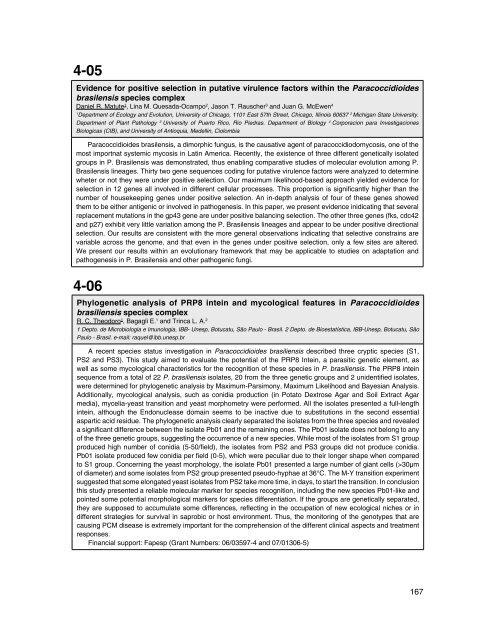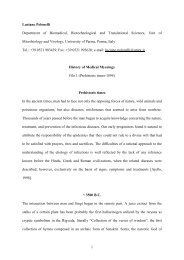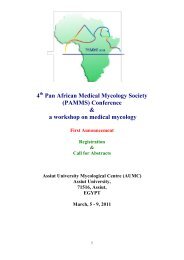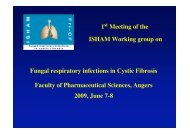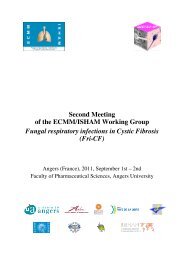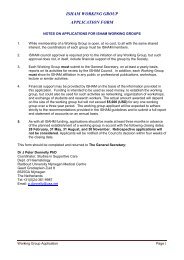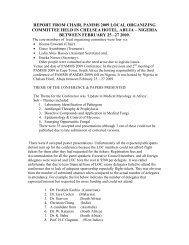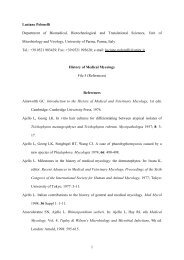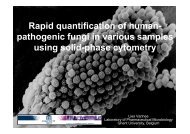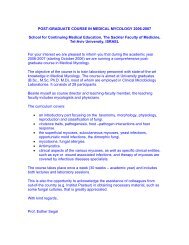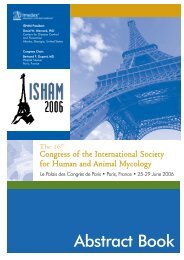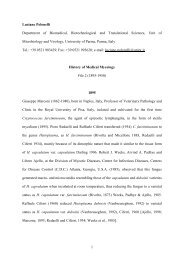Memoria CD.indd - ISHAM
Memoria CD.indd - ISHAM
Memoria CD.indd - ISHAM
Create successful ePaper yourself
Turn your PDF publications into a flip-book with our unique Google optimized e-Paper software.
4-05Evidence for positive selection in putative virulence factors within the Paracoccidioidesbrasilensis species complexDaniel R. Matute 1 , Lina M. Quesada-Ocampo 2 , Jason T. Rauscher 3 and Juan G. McEwen 41Department of Ecology and Evolution, University of Chicago, 1101 East 57th Street, Chicago, Illinois 60637 2 Michigan State University.Department of Plant Pathology 3 University of Puerto Rico, Rio Piedras. Department of Biology 4 Corporacion para InvestigacionesBiologicas (CIB), and University of Antioquia, Medellin, CiolombiaParacoccidioides brasilensis, a dimorphic fungus, is the causative agent of paracoccidiodomycosis, one of themost importnat systemic mycosis in Latin America. Recently, the existence of three different genetically isolatedgroups in P. Brasilensis was demonstrated, thus enabling comparative studies of molecular evolution among P.Brasilensis lineages. Thirty two gene sequences coding for putative virulence factors were analyzed to determinewheter or not they were under positive selection. Our maximum likelihood-based approach yielded evidence forselection in 12 genes all involved in different cellular processes. This proportion is significantly higher than thenumber of housekeeping genes under positive selection. An in-depth analysis of four of these genes showedthem to be either antigenic or involved in pathogenesis. In this paper, we present evidence inidicating that severalreplacement mutations in the gp43 gene are under positive balancing selection. The other three genes (fks, cdc42and p27) exhibit very little variation among the P. Brasilensis lineages and appear to be under positive directionalselection. Our results are consistent with the more general observations indicating that selective constrains arevariable across the genome, and that even in the genes under positive selection, only a few sites are altered.We present our results within an evolutionary framework that may be applicable to studies on adaptation andpathogenesis in P. Brasilensis and other pathogenic fungi.4-06Phylogenetic analysis of PRP8 intein and mycological features in Paracoccidioidesbrasiliensis species complexR. C. Theodoro 1 , Bagagli E. 1 and Trinca L. A. 21 Depto. de Microbiologia e Imunologia, IBB- Unesp, Botucatu, São Paulo - Brasil. 2 Depto. de Bioestatística, IBB-Unesp, Botucatu, SãoPaulo - Brasil. e-mail: raquel@ibb.unesp.brA recent species status investigation in Paracoccidioides brasiliensis described three cryptic species (S1,PS2 and PS3). This study aimed to evaluate the potential of the PRP8 Intein, a parasitic genetic element, aswell as some mycological characteristics for the recognition of these species in P. brasiliensis. The PRP8 inteinsequence from a total of 22 P. brasiliensis isolates, 20 from the three genetic groups and 2 unidentified isolates,were determined for phylogenetic analysis by Maximum-Parsimony, Maximum Likelihood and Bayesian Analysis.Additionally, mycological analysis, such as conidia production (in Potato Dextrose Agar and Soil Extract Agarmedia), mycelia-yeast transition and yeast morphometry were performed. All the isolates presented a full-lengthintein, although the Endonuclease domain seems to be inactive due to substitutions in the second essentialaspartic acid residue. The phylogenetic analysis clearly separated the isolates from the three species and revealeda significant difference between the isolate Pb01 and the remaining ones. The Pb01 isolate does not belong to anyof the three genetic groups, suggesting the occurrence of a new species. While most of the isolates from S1 groupproduced high number of conidia (5-50/field), the isolates from PS2 and PS3 groups did not produce conidia.Pb01 isolate produced few conidia per field (0-5), which were peculiar due to their longer shape when comparedto S1 group. Concerning the yeast morphology, the isolate Pb01 presented a large number of giant cells (>30µmof diameter) and some isolates from PS2 group presented pseudo-hyphae at 36°C. The M-Y transition experimentsuggested that some elongated yeast isolates from PS2 take more time, in days, to start the transition. In conclusionthis study presented a reliable molecular marker for species recognition, including the new species Pb01-like andpointed some potential morphological markers for species differentiation. If the groups are genetically separated,they are supposed to accumulate some differences, reflecting in the occupation of new ecological niches or indifferent strategies for survival in saprobic or host environment. Thus, the monitoring of the genotypes that arecausing PCM disease is extremely important for the comprehension of the different clinical aspects and treatmentresponses.Financial support: Fapesp (Grant Numbers: 06/03597-4 and 07/01306-5)167


